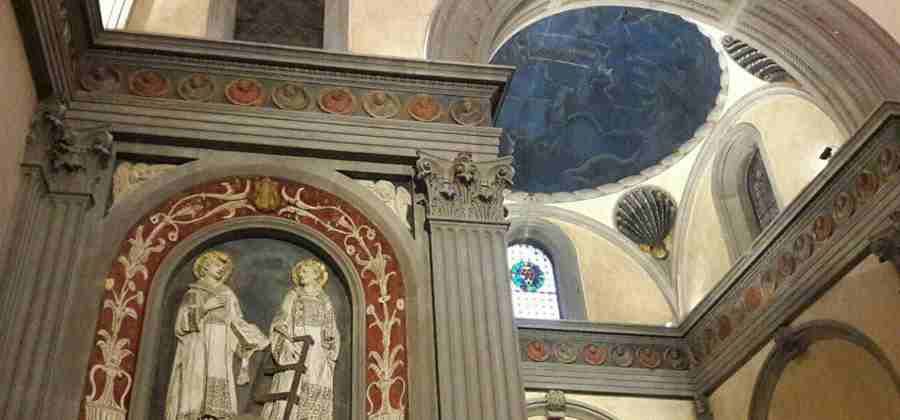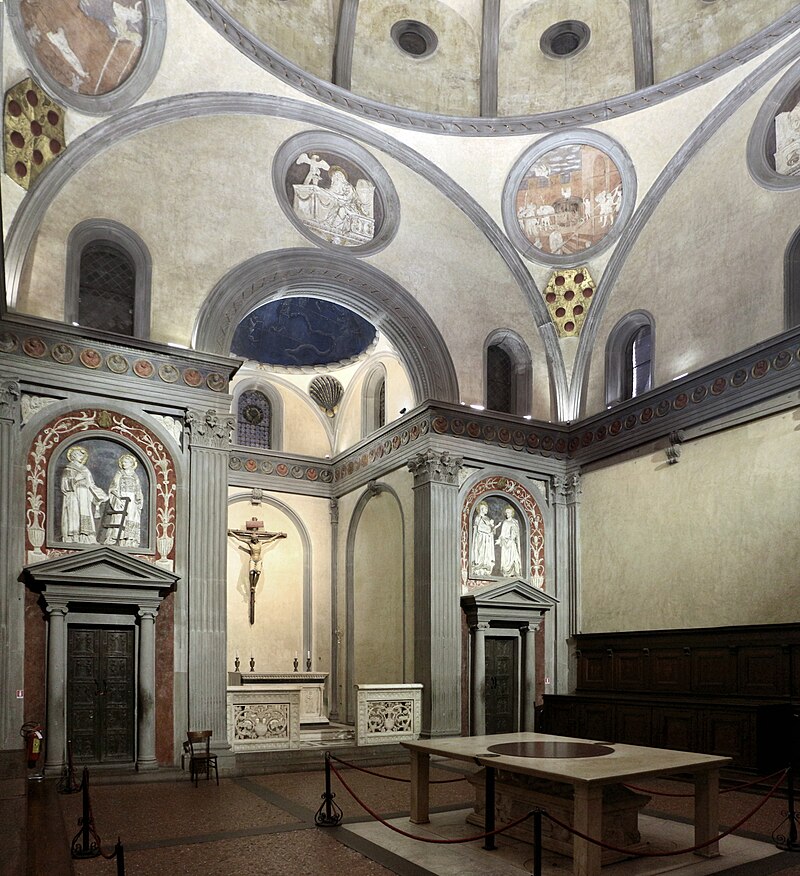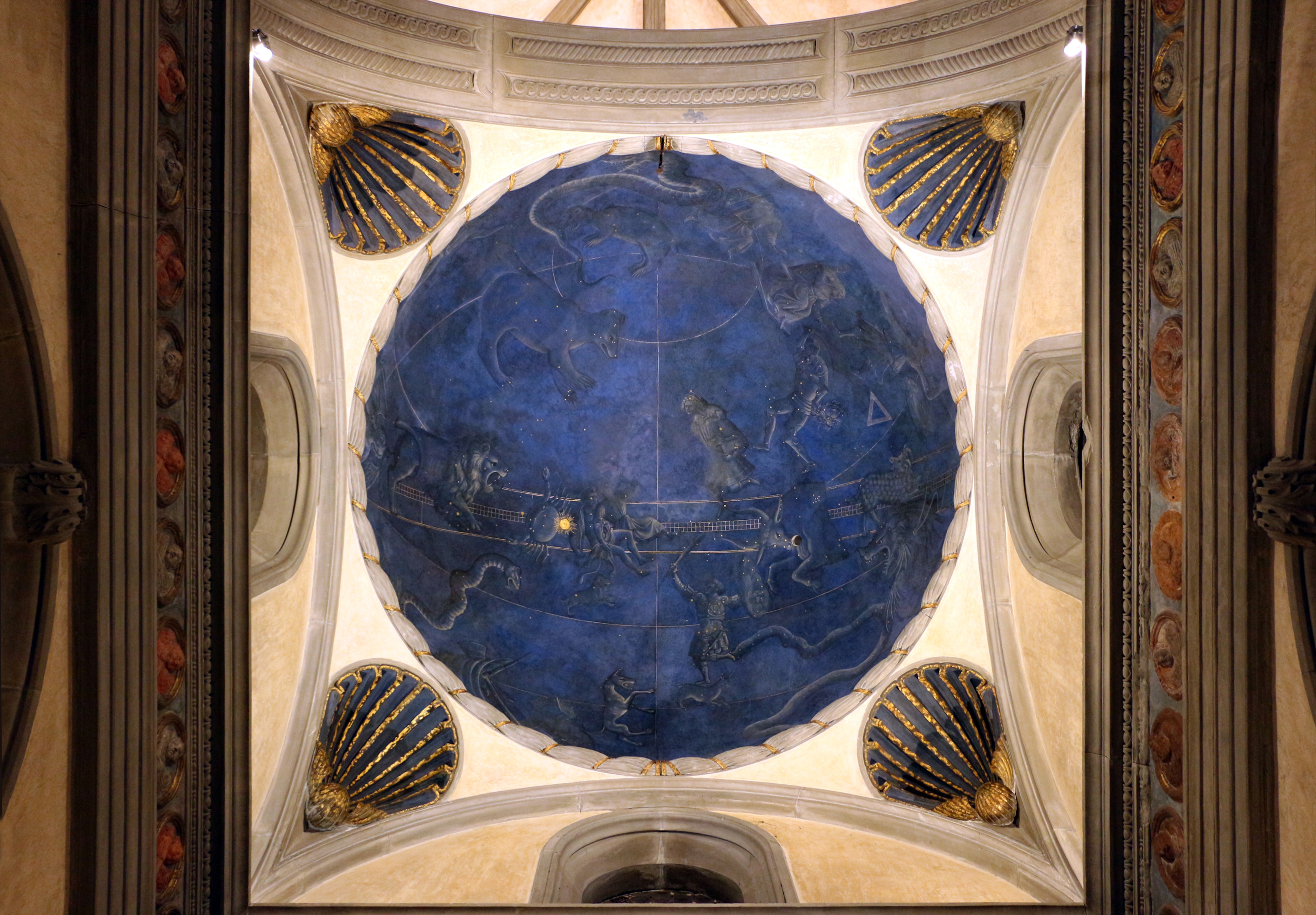
Are you ready to discover an authentic jewel of the Florentine Renaissance? I invite you to immerse yourself in the history and art of Florence as I guide you to discover the extraordinary Old Sacristy. Located inside the Basilica of San Lorenzo, this magnificent work of art created by Filippo Brunelleschi for the Medici family is a true architectural and cultural landmark. Before you embark on this fascinating adventure, however, be sure to explore some of the other wonders Florence has to offer. Find out more about what to see in Florence.
Now, let yourself be fascinated by the history and secrets of this extraordinary Renaissance work of art, the Old Sacristy.
The Old Sacristy, a masterpiece by Brunelleschi in Florence

The history of the Old Sacristy has its roots in the heart of the Florentine Renaissance. It was the wealthy banker Giovanni di Bicci de’ Medici who commissioned Filippo Brunelleschi, around 1420, to design and build this magnificent funerary chapel. Giovanni di Bicci wanted the Old Sacristy to be the mausoleum for his family, an eternal home for his loved ones and himself.
HISTORY OF THE OLD SACRISTY
The choice of San Lorenzo as the burial place was significant. The church was one of the most important religious buildings in the area and the oldest in Florence. Moreover, it was located a short distance from Via Larga, where the Medici family resided. This strategic position testified to the power and influence that the Medici had acquired in Florentine society at the time.
The project for the Old Sacristy envisaged a separate room, a funerary chapel of great architectural and artistic refinement. Brunelleschi, known for his mastery in the art of architecture, worked personally to complete this extraordinary work. The work took about eight years, and the date of completion is attested by a parchment found in the dome.
After the death of Giovanni di Bicci in 1429, the chapel was used for the sumptuous funeral of the banker, and Donatello was commissioned to decorate it with painted and gilded stuccoes. The works of art created by the author of Donatello’s David were the Stories of St. John the Evangelist and the Four Evangelists, together with the series of Cherubs and Seraphim in the entablature, gave the Old Sacristy an atmosphere of extraordinary beauty and spirituality.
However, the collaboration between Brunelleschi and Donatello was not without conflict.
Brunelleschi accused Donatello of distracting attention from the architectural details of the chapel through an almost excessive use of colour in the frescoes. These disagreements led to Donatello’s removal from the decoration of other works commissioned from Brunelleschi, such as the Pazzi Chapel.
Despite the controversies, the Old Sacristy established itself as a Renaissance masterpiece and a benchmark for future architectural projects. Its refinement, balance between architecture and art, and profound spiritual significance still make it one of Florence’s most fascinating attractions.
WHAT TO SEE IN THE OLD SACRISTY
The Old Sacristy is a true treasure trove of artistic and architectural treasures from the Florentine Renaissance. The room, designed by Filippo Brunelleschi as a separate work within the Basilica of San Lorenzo, is characterised by a quadrangular plan divided into four compartments, but it is the main compartment that immediately captures the attention of visitors.
In the centre of the main chamber is the sumptuous tomb of Giovanni di Bicci de’ Medici and his wife Piccarda, created by Donatello. This majestic burial is a masterpiece of Renaissance sculpture, a perfect balance between the purity of the lines and the expressiveness of the sculpted faces. The statues depicting the deceased are accompanied by allegories of the cardinal virtues, symbolising their high morality and importance in Florentine society.
The walls and dome are decorated with painted and gilded stuccoes, depicting scenes from the lives of the saints, including the ‘Stories of St. John the Evangelist’ and the ‘Four Evangelists’. These narrative frescoes convey a sense of movement and vitality, creating a kind of sacred theatre within the chapel.
Another striking element is the mysterious painting of the starry sky on the dome, dating back to the night of 4 July 1442. The constellations and stars are made of gold, and the use of azurite to paint the sky lends a magical atmosphere to the entire room. The work is attributed to Giuliano d’Arrigo, known as Il Pesello, on the instructions of the astronomer Paolo dal Pozzo Toscanelli, a friend of Brunelleschi.
As well as being aesthetically incredible, the painting has aroused various hypotheses regarding its dating and significance. Some suggest that it may be connected to the arrival of Renato d’Angiò in Florence, while others speculate on a symbolic meaning related to the rivalry between the Medici and Pazzi families.
HOW TO VISIT THE OLD SACRISTY
In order to visit the Sacristy and the Basilica of San Lorenzo complex, it is necessary to purchase a ticket to the Old Sacristy.
This ticket grants access to the Basilica of San Lorenzo, the Old Sacristy, the Cloisters, the Treasury Museum, the crypt and the monumental underground areas.
Timetable
Access to the Basilica is permitted from Monday to Saturday from 9:30 a.m. to 5:30 p.m., with the last access at 4:30 p.m.

Il Cielo Stellato della Sagrestia Vecchia di Firenze
The Old Sacristy in Florence is an authentic marvel of the Italian Renaissance, definitely worth a visit during your stay in the city. The harmony between Brunelleschi’s architecture and Donatello’s frescoes, together with the mystery of the starry sky, make this a unique and fascinating destination.
Get ready to immerse yourself in the elegance of the past and discover the history of one of the most influential families in the history of art. Enjoy your trip to discover the Old Sacristy of Florence!

